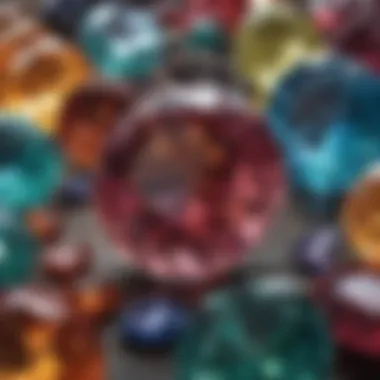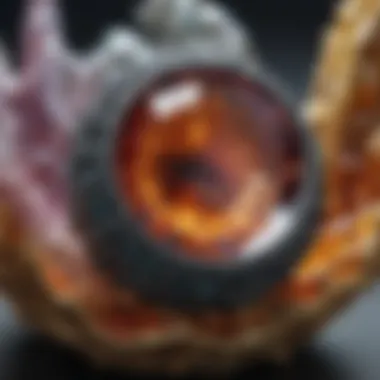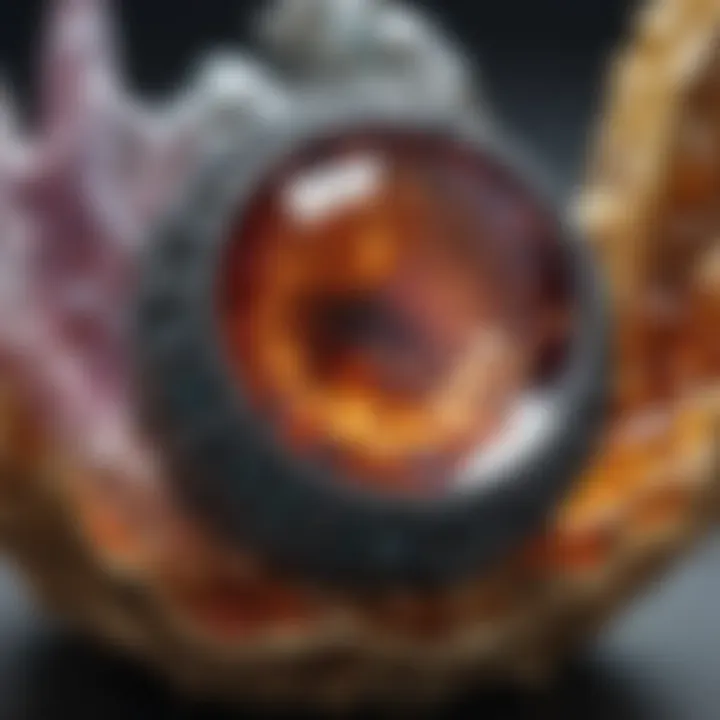Exploring Earth Gemstones: Formation, Significance and More


Intro
The world of gemstones is a splendid tapestry woven with history, culture, and natural wonder. Each stone tells a unique tale, from how it formed deep within the Earth to the way different societies have revered its beauty and mystique. This article delves into these marvels, offering you a peek behind the curtain to understand not just their physical properties, but also their significance in various practices around the globe. Together, we will travel through time, discovering how these treasures have impacted human civilization.
Gemstone Overview
Definition and Origins
Gemstones, at their core, are minerals or organic materials that have been cut and polished for decorative purposes. They come in a multitude of colors, shapes, and sizes, each with distinct qualities that set them apart. While most gemstones establish their fame through beauty, it’s their rarity and the processes that lead to their formation that truly define them.
Many gemstones originate through geological processes that take thousands, if not millions, of years. For instance, the alluring diamond forms under conditions of extreme heat and pressure found deep within the Earth’s mantle. In contrast, amber, a wonderfully warm golden-hued gem, is actually fossilized tree resin and creates a diverse narrative of its own. The origins of these gemstones are stories for themselves, each telling a tale of Earth's dynamic processes.
Historical Significance
Throughout history, gemstones have held a place of significance that transcends mere adornment. Ancient civilizations, from the Egyptians to the Mayans, revered certain stones for their supposed magical properties. Sapphire, for example, was seen as a symbol of wisdom among the Persians, while the emerald was highly prized in ancient Egypt, believed to be the sacred stone of the goddess Isis.
These stones were not only valued for their beauty but were often intertwined with cultural beliefs or practices. They were used as talismans or for protection, often embedded in armor or worn as part of ceremonial garb. In various cultures, gemstones such as turquoise were believed to invoke good luck and ward off evil spirits, showcasing the blend between spirituality and materiality in human history.
Gemstone Properties
Hardness and Durability
When selecting a gemstone, two critical properties that come into play are hardness and durability. These features not only determine how well a gemstone fares in everyday wear but also reflect their natural process of formation. The Mohs scale of hardness is often referenced, with diamonds sitting at the top as the hardest known natural material. Stones like sapphire and ruby, both varieties of corundum, follow closely, making them excellent choices for rings and bracelets that endure frequent use.
On the flip side, softer stones like opals and pearl demand a delicate approach in handling and care. Owners should understand these characteristics well to ensure their cherished pieces maintain their luster through the years.
Color and Clarity
Color and clarity are fundamental attributes that significantly influence a gemstone's value and appearance. Stone color is not just about hue; it includes saturation and tone which interplay to create a gemstone's overall visual appeal. A striking blue topaz, for instance, with its vibrant saturation, captivates the eye and often takes center stage in any jewelry piece.
Clarity, on the other hand, assesses the transparency of the gemstone and presence of inclusions. High-quality gemstones are often clearer and nearly flawless, adding to their desirability. However, some inclusions can add character and make each stone feel unique.
"Every gemstone is like a book, waiting to reveal its story to those who know how to read it."
Unwavering attention to these facets creates a deeper appreciation for the gemstones, turning casual admirers into informed collectors who value the intricacies of these Earthly gems.
Prelims to Earth Gemstones
Understanding earth gemstones is not just about their beauty, it encapsulates a complex interplay of geology, history, and cultural significance. These natural treasures are far more than shiny relics; they represent millennia of geological processes, embodying stories of the earth itself. The importance of earth gemstones in this article lies in their multifaceted charm and the myriad factors that contribute to their allure.
Exploring gemstones connects us to the Earth's own narrative, revealing how minerals undergo transformation under immense pressure and heat to form crystals that captivate the human eye. This section sets the stage for a deep dive into everything from their formation to their spiritual implications, as well as their place in contemporary society.
The insight gleaned here is invaluable for gemstone enthusiasts, collectors, and even jewelers. Knowing more about these gems can enhance appreciation, guide collectors in making informed choices, and inspire designers to incorporate these precious stones thoughtfully into their work. As we traverse through the subsequent sections, it's clear that each gemstone carries a tale waiting to be deciphered.
Definition and Overview
Earth gemstones, or more commonly referred to as gemstones, are defined as precious or semi-precious stones that have been cut and polished for use in jewelry. But this definition barely scratches the surface. The term encompasses a vast range of minerals, some of which are rarer than others and yield unique properties and forms. The beauty and rarity of these stones are typically what classifies them as gemstones.
Take diamond, for instance. It's not just a sparkling crystal; it's a piece of pressurized carbon that has endured countless eons of geological change. Other examples include the vibrant ruby, a variety of corundum, and the deep blue sapphire, which evoke both admiration and desire. Each of these stones shares a common origin within the Earth’s crust, yet their individual characteristics dictate their appeal and valuation.
Furthermore, these gemstones come in a myriad of colors and shapes, with properties such as refractive index and hardness playing a significant role in their classification. It’s also worth noting that these unique characteristics are the result of their specific formation conditions, which reflects not only the geological realm but also the ingenuity of nature.
Historical Context
The history of gemstones is as rich as the gems themselves. From ancient civilizations like the Egyptians, who adorned their tombs with lapis lazuli and turquoise, to modern times where diamonds symbolize love and commitment, gemstones have always held significance beyond their physical properties.
In reality, the journey of gemstones through time offers insight into cultural evolution. Various societies have attributed meanings to different stones, with beliefs often interwoven into spiritual practices and astrological traditions. For example, amethyst has long been considered a stone of sobriety and clarity, while emerald has been associated with fertility and rebirth.
Moreover, gemstones have often played a role as symbols of status and power. Kings and queens adorned themselves with lavish amounts of gold and jewel-encrusted pieces, showcasing their wealth and influence. Even today, various gems are still used in crowns and royal regalia, linking us continually to this historical narrative. Each gem thus carries its own legacy, influencing perception and trade throughout the ages.
Understanding the history of these gemstones allows collectors and enthusiasts not only to appreciate their aesthetic value but also to grasp their deep-rooted connections to human culture.
"Gemstones are not merely geological formations; they encapsulate the essence of cultures, struggles, and aspirations over thousands of years."
The Formation of Gemstones
The journey of gemstones from their origins deep within the Earth to glittering pieces of jewelry is a tale filled with intricate processes and time. Understanding the formation of gemstones is crucial for enthusiasts, collectors, and designers who wish to appreciate not just the beauty, but also the history and significance behind each stone. The processes of formation not only define the characteristics of gemstones but also influence their value, rarity, and mystical connotations.
Geological Processes
Gemstones are birthed within the heart of the Earth, where immense pressures and heat create the right conditions for their formation. The vast majority of these stones arise from two main geological processes: igneous processes, which occur from molten rock, and metamorphic processes, which transform existing minerals under great heat and pressure.
- Igneous Formation: This process originates from the cooling and solidifying of magma. As magma rises through the Earth’s crust and eventually cools, crystals begin to form. This is particularly true for gemstones like diamonds and emeralds, which are formed under extreme conditions. For instance, diamonds, formed over billions of years, require the correct mix of carbon and the right environmental factors, usually found deep within the Earth.
- Metamorphic Formation: This is where existing rocks undergo significant changes due to temperature and pressure. A classic example includes the transformation of limestone into marble, where certain conditions might yield highly valued stones such as garnet. This metamorphic process highlights the incredible adaptability of minerals, showing how they can morph into exquisite variations.
Understanding these geological processes is vital for gem enthusiasts keen on identifying the origins of their favorite stones. It also highlights the need for responsible sourcing, as the conditions leading to their formation often depend on local ecosystems and geological stability.
Crystallization Mechanisms
Once the minerals have formed, another essential step occurs: crystallization. This is the process where minerals arrange themselves in a structured, geometric format, leading to the formation of the beautiful crystals we admire.
- Nucleation: The very first stage of crystallization is nucleation. This is where the initial microscopic crystals form, providing a nucleus for larger crystals to grow. In many gemstones, this process can take millions of years, making the final product a true treasure of nature.
- Growth: Following nucleation, the crystals continue to grow as more and more molecules attach themselves to the forming crystal structure. This process is heavily influenced by the temperature and surrounding conditions. For example, the slow cooling of magma can create larger and more well-defined crystals, such as those seen in quartz.
- Inclusions: During growth, there can be interruptions which may lead to inclusions—imperfections within the crystal, often created by foreign materials. These unique characteristics can significantly affect a gemstone's value, as they tell a story about the stone's journey through the Earth.
A deeper insight into crystallization mechanisms not only enriches one’s knowledge but also adds a layer of appreciation for the handiwork of nature. Knowing that each gemstone is a time capsule of Earth’s history enhances the connections individuals have with their gemstones.
Understanding the formation and crystallization of gemstones is key for anyone interested in the harmony of geology and beauty.
Classification of Earth Gemstones
Classifying earth gemstones is essential for more than just the sake of organization; it serves as a guiding compass in the vast and intricate world of gemstones. Understanding how different gemstones are categorized allows enthusiasts, collectors, and jewelry designers to navigate their choices effectively. This classification can have profound implications, influencing everything from purchasing decisions to gemstone lore and cultural significance.


Gemstones are broadly classified into two primary categories: precious and semi-precious stones. This fundamental distinction is often linked to the historic valuation of gemstones but has evolved into a more nuanced classification based on factors such as rarity, beauty, and durability.
Precious vs Semi-Precious Stones
The traditional notion of precious stones encompasses four main types: diamond, ruby, emerald, and sapphire. These stones are typically more sought-after due to their relative rarity and remarkable beauty. The allure of these gemstones has transcended cultures and centuries, making them a symbol of status and wealth. For instance, diamonds have long been associated with love and commitment, while sapphires are often linked to royalty and wisdom.
On the flip side, semi-precious stones cover a vast variety of gemstones that, despite being less rare, hold their own charm and significance. Amethyst, turquoise, garnet, and a host of others fall into this category. They offer myriad colors, patterns, and unique qualities, appealing to a wide audience for both ornamental and metaphysical purposes.
"The beauty of semi-precious stones lies in their diversity; they tell stories through their colors and textures, captivating the imagination of collectors."
While the differentiation between precious and semi-precious stones brings some clarity, it’s worth noting that this classification does not necessarily imply superiority. In some circles, the uniqueness of semi-precious stones has made them equally prized, particularly for modern jewelry designers and those who appreciate the intricate details and meanings behind each stone.
When evaluating gemstones, aside from their classification, one must also consider factors like quality and craftsmanship. For example, a well-crafted piece featuring semi-precious stones can often rival a simple piece of jewelry made with precious stones in terms of aesthetic appeal.
Color Varieties and Their Significance
The classification of gemstones continues to extend into the realm of color varieties and their significance. Color is often the first attribute that captures the eye, making it a crucial component in the categorization of gemstones. Each shade of a gemstone can convey a different meaning or emotional resonance, which contributes to various cultures and belief systems surrounding gemstones.
For instance, blue sapphires are celebrated not just for their beauty but also for their associations with truth and sincerity. In contrast, red garnets are often linked to love and passion, making them a popular choice for romantic gifts.
Additionally, the phenomenon of pleochroism, wherein a gemstone appears to change color when viewed from different angles, adds layers of fascination. Tourmaline is well-known for this quality, exhibiting a beautiful blend of colors that can shift and morph—a perfect example of nature's artistry.
In today’s world, the significance of color in gemstones is being recognized and celebrated more than ever. Collectors and designers are increasingly drawn to unique color variations and the stories behind them.
By understanding the classification of earth gemstones, both precious and semi-precious, alongside their various colors, individuals can deepen their appreciation and enhance their decision-making processes regarding gemstone acquisitions. The journey through this classification not only enriches one's knowledge but also instills a greater respect for the earth's treasures.
Physical and Chemical Properties
Understanding the physical and chemical properties of gemstones is paramount. These characteristics not only determine the stone's durability and beauty but also play a significant role in its evaluation, classification, and application. Knowledge of these properties helps jewelers in crafting masterpieces, collects in making informed purchases, and geologists in identifying stones in their natural settings.
Hardness and Toughness
Hardness is a critical property that indicates how resistant a gemstone is to scratching and abrasion. It is measured on the Mohs scale, which ranges from talc, the softest mineral, at a score of 1, to diamond, the hardest, at 10. For example, a sapphire ranks at 9 on this scale, making it incredibly durable for daily wear — a preferred choice in engagement rings and other jewelry meant to withstand the test of time.
Toughness, however, is separate from hardness. While hardness measures scratch resistance, toughness assesses a gemstone's ability to withstand breakage or chipping. Different minerals have various combinations of these properties. For instance, while diamonds are exceptionally hard, they can be brittle, easily chipping if struck at the right angle. As such, understanding these distinctions can guide you in jewelry selection and maintenance, ensuring that you choose stones not only for their beauty but for their resilience.
Furthermore, when caring for gemstones, knowing how these properties interact can prevent damage. For example, a softer stone like opal should be stored away from harder gems or abrasive materials to avoid scratches. Similarly, underestimating a stone's toughness could lead to choices that might not be suitable for an active lifestyle.
"It's not just the sparkle that counts; knowing how to protect your gemstones enhances their beauty for years to come."
Refractive Index and Luster
The refractive index of a gemstone measures how much it bends light as it enters the material. This phenomenon is crucial for creating the brilliance and fire that gemstones exhibit. Each type of gemstone has a unique refractive index, which can be a distinguishing factor in identification. For instance, emeralds have a refractive index ranging from 1.577 to 1.583, contrasted with quartz, which ranges from 1.54 to 1.55. Jewelers utilize this property to emphasize a stone’s luster, which refers to how light interacts with the stone's surface. Luster can range from vitreous (glassy) in garnets to silky in nephrite jade.
Understanding these properties is not just academic; it directly affects how a gemstone is cut and polished. For example, the way light enters and exits a diamond during the cutting process is essential to maximize its brilliance. Poor cuts can result in gems that look dull rather than dazzling because they fail to reflect light adequately. Thus, learning how to assess luster through testing and observation can significantly impact the approximate value and aesthetic appeal of the stone.
In summary, both hardness and toughness alongside refractive index and luster are invaluable attributes within the realm of gemstones. They equip enthusiasts, jewelers, and collectors with insights needed to appreciate these natural wonders fully. In your exploration of earth gemstones, these properties are not mere technicalities but rather keys to understanding the gem beneath the surface.
The Metaphysical Aspects of Gemstones
The metaphysical aspects of gemstones hold a unique place in the world of mineralogy and human culture. They go beyond the mere physical attributes of these natural treasures, delving into how they resonate with human emotions, spiritual beliefs, and even our very sense of well-being. With many people turning to holistic practices, the interest in the healing properties of gemstones is at an all-time high. These stones are often perceived as possessing vibrations that can influence our state of mind and health, serving as tools for meditation, healing, and spiritual growth. Understanding this dimension of gemstones adds depth to their value, as they bridge the gap between the earth and the ethereal.
Healing Properties
Throughout history, various civilizations have harnessed the alleged healing properties of gemstones. For example, amethyst is often touted for its calming effects, believed to release negative energies and promote tranquility. People sometimes keep an amethyst under their pillow to ward off insomnia.
In many cultures, rose quartz is linked to love and compassion. It’s not just a pretty stone; it’s thought to open the heart chakra, allowing for deeper emotional connections. Specific stones are associated with specific ailments or emotional states, with intuitive practitioners recommending different stones for various needs.
Interestingly, there exists a fusion of traditional wisdom and modern practices. Crystal therapists often utilize combinations of stones to tackle complex issues, from anxiety to physical pain. When selecting a stone for healing, it’s said that intuition plays a crucial role; one must feel a connection with the stone, as if it speaks to their inner self. Some even suggest carrying a small piece of a gemstone daily to absorb its energies.
"The power of gemstoneds lies less in the stones themselves and more in the belief systems that surround them."
Cultural and Spiritual Significance
Cultural perspectives on gemstones vary widely, each infusing their own beliefs and narratives into their significance. To ancient Egyptians, turquoise represented protection and was often found in the tombs of the wealthy, symbolizing their journey to the afterlife. In contrast, the diamond, a symbol of eternal love in many cultures today, was historically associated with power and strength.
In many Indigenous cultures, gemstones are more than mere decorative objects. They serve as sacred tools in rituals and festivities. For a Lakota Sioux, black tourmaline is considered protective and is often used in ceremonies to ward off negativity. Similarly, in Hindu traditions, certain stones such as the sapphire can be tied to planetary influences, impacting one’s karma and life journey.
Furthermore, the popularity of gemstones has surged in the age of social media. Many influencers utilize their platforms to spread awareness about the spiritual value of these stones, discussing their personal experiences and promoting their use for mindfulness and self-care practices.
Gemstone Care and Maintenance
Maintaining gemstones is crucial for ensuring their beauty, longevity, and overall value. These precious stones, while resilient in their own right, are susceptible to various forms of damage if not cared for properly. The importance of gemstone care spans from preserving their physical integrity to honoring the cultural significance they hold. Neglecting this aspect can lead to diminished sparkle and even irreversible harm, so taking the time to understand proper care techniques is essential for any gemstone owner.
Cleaning Techniques
Keeping gemstones clean not only boosts their appearance but also prevents the buildup of dirt and oils that can cloud their surfaces. Here are some effective cleaning methods:
- Warm Soapy Water: A traditional method that works wonders. Mix a few drops of mild dish soap in warm water. Soak the gemstone briefly and gently scrub with a soft brush.
- Ultrasonic Cleaners: These gadgets can be a gem lover's best friend. They use high-frequency sound waves to produce microscopic bubbles in water that agitate and dislodge any grime without damaging the stone. However, use caution; some stones like opals are sensitive to ultrasonic cleaning.
- Steam Cleaning: This is another alternative but can be harsh. A steam cleaner can restore shine but is not suitable for porous gemstones.
"Regular cleaning is key to maintaining the allure of your gemstones. A little care goes a long way."
Ensure you rinse the stones thoroughly afterward and towel dry them gently. Never use harsh chemicals or abrasive materials, as they can scratch or penetrate the stone's surface.
Storage Recommendations
Proper storage is just as important as cleaning. How you store gemstones can prevent scratches, chips, and degradation. These are some best practices:
- Separate Storage: Store each gemstone separately, ideally in soft pouches or individual compartments. This prevents them from rubbing against each other or other hard surfaces, reducing the risk of damage.
- Avoid Direct Sunlight: Prolonged exposure to sunlight can fade the color of some gemstones. Store them in a cool, dark place, preferably in a box designated for jewelry. Consider using anti-tarnish strips in metal storage boxes to further protect them.
- Use Desiccants: Humidity can lead to issues like mold or degradation in porous stones. Incorporating silica gel packs into the storage solution can help absorb moisture.
- Check Occasionally: Even in storage, gemstones should be checked periodically. This ensures that they remain in good condition and allows for timely intervention if any issues arise.
In summary, taking care of gemstones is a blend of art and science. Maintaining their cleanliness and ensuring safe storage opens the door to a world where these beautiful natural creations can shine their brightest.


Identifying Authentic Gemstones
When it comes to the impressive world of gemstones, knowing how to identify authentic pieces is crucial. The repercussions of acquiring a fake can hit not just the pocketbook but also the heart, particularly for collectors. Each gemstone carries its own story, and an authentic specimen allows one to fully appreciate that narrative. In this section, we’ll explore both the physical signs that can help delineate genuine gemstones from look-alikes and the advanced tools available to enthusiasts today.
Physical Indicators
Recognizing an authentic gemstone starts with some familiar indicators that anyone can observe. Here are some core physical traits to look out for:
- Color: Genuine gemstones often exhibit color variations and inclusions, which contribute to their richness. For example, natural sapphires might show subtle color zoning, while synthetic versions typically have a uniform hue.
- Inclusions: Real gemstones often contain natural inclusions that can be seen under magnification. These might be tiny bubbles or flaws that resemble needle-like structures, known as rutile. Synthetic stones usually lack these imperfections.
- Weight: An essential aspect of legitimacy lies in the heft of the stone. Genuine gemstones are usually denser than imitations made from glass or plastic. A simple way to test this is to compare with a known authentic stone of the same type.
- Hardness and Scratch Resistance: Using a common hardness scale, you can discern authentic pieces. For example, a genuine diamond, rated at 10, should not be scratched by any household metal.
These indicators possess their own advantages: they are accessible and can be done quickly. However, they also require a practiced eye. Often, several signs need to be considered together for a definitive conclusion.
Technological Tools and Methods
While physical indicators can provide solid clues, technology has ushered in a new era of gemstone evaluation. Various methods and tools can yield far more reliable results. Key technological advancements include:
- Spectroscopy: This is a method that analyzes the light absorbed by a gemstone to identify its chemical composition. Each gemstone emits a unique light spectrum, making this tool invaluable.
- Refractometer: This device helps determine the refractive index of a gemstone, which indicates how much light is bent as it enters the stone. Knowing this value can help experts pinpoint the kind of gemstone they’re dealing with.
- UV Light Testing: Some gems fluoresce under ultraviolet light. This property can aid in authentication, as certain synthetic stones do not have the same response as their natural counterparts.
- CT Scanning: While this may seem excessive, computed tomography scans can reveal the internal structure of gemstones, uncovering information about their origin and the presence of enhancements that might affect their value.
The use of technology can provide high levels of reliability when determining the authenticity of gemstones. However, many of these methods are best handled in professional settings, particularly when high-value stones are concerned.
The ability to distinguish between genuine gemstones and imitations is not just an asset; it's a skill that enhances the collector's journey.
In sum, both physical indicators and technological tools play vital roles in authenticating gemstones. Regularly honing the ability to recognize these elements can prove beneficial—certainly worth the investment of time for anyone serious about their passion for gemstones.
Gemstones in Jewelry
Gemstones have long been the sparkling stars in the universe of jewelry making. Their natural beauty, combined with cultural significance and unique properties, make them not just decoration but storytellers in their own right. In the world of adornment, gemstones transform ordinary pieces into something that speaks volumes about personal taste, wealth, and even aspirations.
From ancient crowns to modern-day engagement rings, the inclusion of gemstones in jewelry serves myriad purposes. They are sought after not only for their aesthetic appeal but also for their supposed mystical and healing properties. Jewelry adorned with gemstones often carries a personal story—be it a birthstone symbolizing a special month or a family heirloom steeped in history.
Types of Jewelry Incorporating Gemstones
When expressing one's individuality, gemstones fit like a glove into various types of jewelry. Here are some notable categories:
- Rings: Engagement and wedding rings typically feature diamonds, while birthstone rings bring a personal touch to the finger.
- Necklaces: From simple pendants to elaborate statement pieces, gemstones hang gracefully around the neck, drawing attention without saying a word.
- Bracelets: These pieces often integrate a blend of gemstones and metals, creating a harmonious accessory that can be both casual and elegant.
- Earrings: Gemstone earrings can range from the understated elegance of stud earrings to the vibrant allure of chandelier designs.
Thus, jewelry incorporating gemstones plays a significant role in modern fashion. Each piece serves as a form of self-expression, mood, and intention.
Design Trends and Innovations
As we step into the world of creativity in jewelry design, innovation is at the forefront. Gemstones are being reimagined, showcasing not only beauty but also pushing the boundaries of traditional craftsmanship.
- Mixed Materials: Today, designers are combining unconventional materials like resin or recycled metals with gemstones to create unique textures and styles. The playful juxtaposition of hardness and softness, shine and matte, can make for captivating pieces.
- Minimalism: The emphasis on simple and clean lines highlights the natural beauty of gemstones, often featuring a single stone as the star of the show. Designers focus on showcasing the raw facets of gems, allowing their inherent qualities to shine.
- Sustainable Practices: There's been a noticeable shift toward ethically sourced stones and environmentally friendly production methods. Consumers are gravitating toward pieces that tell a story, and these trends have arisen as a response to growing environmental consciousness.
The artwork of gemstone jewelry design is storytelling—it's about evoking emotions and creating connections.
As new trends come and go, the persistent allure of gemstones remains intact. Their role in jewelry is not merely trivial; it is deeply interwoven with culture, significance, and identity.
The Economic Value of Gemstones
When we ponder the world of gemstones, it’s easy to get lost in the captivating colors and mesmerizing cuts. Yet, behind each sparkling stone, there lies a world of economic significance that shapes industries and lives. Understanding the economic value of gemstones is crucial, not only for collectors and jewelry designers but also for those who engage in ethical sourcing and sustainable practices. The monetary worth of these earth treasures extends beyond their beauty; it reflects social dynamics, trade patterns, and even cultural shifts within societies.
Market Trends and Influences
In today’s fast-paced market, gemstone trends are like the weather—constantly changing and decidedly unpredictable. Several factors can shift the demand for certain stones dramatically. For example, with the rise of social media influencers showcasing unique designs and rare finds, previously underappreciated gems can suddenly find themselves in high demand. A recent trend has been the overwhelming interest in colored diamonds, which are becoming the talk of the town. The once underrated brown diamonds, often dismissed as 'chocolate diamonds', are now sought after for their unique hues. The volatility of fashion plays a significant role; as preferences evolve, so does the market.
On the other hand, economic conditions greatly impact gemstone prices. During economic downturns, luxury items like high-end jewelry may see a slump in sales, while during boom periods, there’s often a surge in demand for fine gems. Historical events also cast a long shadow; for instance, the COVID-19 pandemic reshaped retail space, pushing more buyers online. Purchasing habits have fundamentally shifted towards convenience and safety, showcasing the need for dealers to adapt.
"Market dynamics are no longer static; they ebb and flow based on trends, economic climate, and social influences."
In this volatile market, it's essential for enthusiasts and investors alike to stay attuned to these shifts, ensuring they make informed decisions about their acquisitions.
Investment Potential
Investing in gemstones can be as intricate as the stones themselves. Unlike conventional investments, the gemstone market offers unique advantages and, of course, challenges. One primary appeal is the potential for significant returns. Historically, rare colored gemstones like rubies and sapphires have appreciated in value, often outperforming traditional stock markets. But, just like mining for genuine gems, investing carries risks.
The key to navigating this space is research—knowing precisely what to look for in terms of quality, rarity, and market demand. Evaluating gemstones’ investment potential involves:
- Rarity: The fewer there are, the more valuable they become. For example, consider the vibrant pink diamonds, which are incredibly rare.
- Quality: Stones with higher quality, free from inclusions and boasting vivid colors, naturally command higher prices.
- Certification: Authentic stones backed by reputable gemological laboratories, such as the Gemological Institute of America, carry a premium.
However, it’s not just about monetary value; the emotional value of gemstones should also be considered. Many collectors find joy in understanding the history and stories of their pieces, creating personal connections that transcend financial aspects. All in all, as with any investment, diversification is key, and gemstones can be an alluring complement to a well-rounded portfolio.
Environmental Considerations
When discussing earth gemstones, one cannot overlook the critical aspect of environmental considerations. The extraction and trade of gemstones, while captivating to collectors and enthusiasts, come with substantial implications for the environment. Understanding these implications not only highlights the responsibility that comes with gemstone ownership but also encourages more sustainable choices in sourcing and utilization.
Ethical Sourcing Practices
Ethical sourcing practices have gained traction as consumers grow increasingly aware of the substantial repercussions that gemstone mining can have on local communities and ecosystems. In regions where gemstones are mined, issues like child labor, unsafe working conditions, and inadequate compensation are rampant. To combat this, initiatives such as the Kimberly Process Certification Scheme have emerged, aiming to prevent the trade of conflict diamonds. These ethical standards advocate for the traceability of gemstones from mine to market, ensuring that they are harvested in a manner that is socially and environmentally responsible.
Moreover, companies are now prioritizing partnerships with responsible miners who respect labor rights and implement sustainable practices. This can include everything from minimizing environmental disruption during excavation to ensuring fair wages for workers. As consumers, supporting brands that adhere to these practices fosters accountability and encourages a more ethical gemstone industry. As you dabble in the world of gemstones, consider asking where and how they were sourced. Doing so empowers you to make informed choices.
Impact of Mining on Ecosystems
Mining for gemstones can have a profound effect on local ecosystems. Digging into the earth not only disrupts the land but also affects water quality, wildlife habitats, and soil health. For instance, land cleared for mining operations can lead to habitat destruction, threatening species that rely on these environments for survival. Additionally, the use of harmful chemicals in the separation of precious stones from ore can contaminate waterways, posing risks to local flora and fauna.
It's important to highlight that not all mining practices are equal. Some operations implement minimal-impact techniques that aim to reduce environmental degradation. Rehabilitation efforts post-mining are also crucial for restoring areas to their natural state. However, this is often the exception rather than the rule, and the burden of these impacts can fall heavily on local communities.
"Sustainable practices are not just a trend; they're essential for the longevity of our planet's resources."
In light of these considerations, it's evident that both jewelers and consumers have a vital role to play in shaping a responsible gemstone industry. By staying informed about the sources and impacts of their purchases, individuals can contribute toward more ethical practices that help preserve the beauty of our planet for generations to come. Environmental sustainability and ethical sourcing go hand in hand, weaving a narrative that respects both the earth and the peoples involved in its rich tapestry of resources.


As you engage with the enchanting world of gemstones, remember that their allure should not overshadow the importance of their origins. Your choices matter.
Global Gemstone Traditions
The world of gemstones is as vast as it is intricate, extending beyond mere appreciation of their beauty. Global gemstone traditions serve as a window into the social fabric of various cultures, capturing historical narratives, beliefs, and practices that define human experience. Across different continents, gemstones have assumed multifaceted roles, sometimes as mere ornaments and at other times as tokens of power or emotional significance.
Understanding these traditions deepens our appreciation for gemstones. It allows gemstone enthusiasts to see the connections between gemstones and the human experience across civilizations. The stories attached to specific stones—such as the captivating tales surrounding the opal in Aboriginal Australian beliefs—speak not only to the cultural importance but also highlight the reverence that different societies posess towards these natural wonders.
Cultural Significance in Various Societies
Gemstones have long held a prominent place in societal constructs around the globe. In many cultures, they symbolize wealth, health, and relationships. For instance, in ancient Egypt, lapis lazuli was prized not only for its vibrant blue color but also for its believed ability to impart wisdom and protection, often adorning the tombs of pharaohs to aid them in the afterlife.
Similarly, the Japanese have a unique appreciation for pearls, associating them with purity and elegance. During wedding ceremonies, pearls are used to denote a bride’s purity and to symbolize the wisdom she will bring into marriage.
"Each gemstone tells a story, weaving together tradition and modernity."
- The importance attached to gemstones can also be seen in various rituals and celebrations.
- In India, for instance, a specific set of gemstones is prescribed for astrological reasons, believed to influence one's personal destiny.
- A ruby might be recommended for someone seeking strength and energy, while a diamond might be chosen for clarity and purity.
In African cultures, gemstones like turquoise and garnet are cherished for their supposed healing abilities. These stones often feature prominently in tribal ceremonies and traditional healer practices, illustrating the strong connection between gemological benefits and cultural health practices.
Mythologies Surrounding Gemstones
The myths surrounding gemstones are often steeped in rich historical context, adding another layer of fascination. Many societies craft intricate legends explaining the origins and properties of specific stones. Take the diamond, for example—its association with invincibility runs deep in many cultures.
In Hindu mythology, diamonds are sometimes said to be born from the tears of the gods, symbolizing divine purity and strength. In ancient Greece, it was believed that diamonds were actually the tears of the gods, showcasing the reverence held for these sparkling stones.
Similarly, folklore from various places often attributes magical qualities to stones. The lore surrounding the amethyst posits that it can guard against drunkenness and promote clarity of mind, which is quite the compliment for this striking purple stone.
- Here are some notable gemstones with their corresponding myths:
- Amethyst: Said to prevent intoxication and promote clear thinking.
- Turquoise: Historically a protector during travel, believed to bring safety and good fortune.
- Ruby: Known as the stone of love, it is thought to spark passion and energy.
Understanding the myths linked to gemstones enriches the narrative of our relationship with these earthly treasures. As collectors, knowing the stories behind each stone can amplify our engagement and add a layer of meaning to our possessions.
Modern Practices in Gemstone Acquisition
In today's world, the acquisition of gemstones has evolved significantly, swaying away from traditional practices towards more modern methods that embrace technology and changing consumer behaviors. This shift holds importance not merely for collectors, but also for gemstone enthusiasts, jewelry designers, and even investors. Understanding these modern practices provides valuable insight into the gemstone market, ensuring that individuals make informed decisions while navigating this intricate landscape.
Online Marketplaces and Their Impact
The rise of online marketplaces dramatically reshaped the way gemstone buying and selling happens. No longer do collectors need to flip through dusty catalogs or trawl local shops for rare pieces; everything is just a click away. Websites like Etsy, eBay, and specialized gems dealers allow users to explore an extensive array of options from all corners of the globe.
Benefits of online marketplaces include:
- Wider Selection: Shoppers gain access to an extensive array of gemstones, from commonly known ones like amethyst to rare finds such as paraiba tourmaline.
- Price Transparency: Unlike physical stores where prices can vary vastly, online platforms often have tools to compare prices, benefiting the customer.
- Customer Reviews: Shoppers can benefit from genuine feedback from buyers, gained through posted reviews. This helps establish trustworthiness of sellers.
- Convenience: Shopping from the comfort of one's home caters to busy lifestyles. The ease of viewing items without the pressure of salespersons rushing you makes the experience far less daunting.
However, these conveniences come with challenges too. Authenticity can be hard to verify purely through a screen. Without physical inspection, buyers could inadvertently end up with a synthetic stone or a misrepresented gem.
The Role of Gem Shows
Despite the digital shift, gem shows continue to be valuable events for the acquisition of gemstones. These shows draw collectors, enthusiasts, and dealers from various backgrounds, all eager to engage in the vibrant atmosphere dedicated to these natural marvels. Attending gem shows provides hands-on access to numerous gems, allowing potential buyers to explore the textures, colors, and structures up close.
Key roles that gem shows play include:
- Networking Opportunities: These events foster connections between gem traders, artists, and collectors, creating an enriching community where knowledge and resources can be shared.
- Education: Workshops and lectures at gem shows offer insights into the latest trends and scientific advancements in gemology. This is crucial for anyone looking to deepen their understanding of gemstones.
- Authenticity Verification: Seeing stones in person drastically reduces the chances of acquiring fakes, as buyers can examine quality and certification more efficiently compared to online shopping.
- Bargaining: Unlike set online pricing, gem shows allow for haggling, which may lead to better bargains or deals than the static prices of websites.
"The gemstone world has adapted, but the essence remains rooted in authenticity and passion. Navigating these new waters requires both caution and enthusiasm."
Modern practices in gemstone acquisition represent a synthesis of the technological and the traditional, each enhancing the other within the quest for nature's beauty.
Future Perspectives on Gemstones
The world of gemstones is not static; it’s an ever-evolving landscape influenced by advances in technology, economic trends, and shifting consumer attitudes. As we gaze into the crystal ball of future perspectives on gemstones, it’s imperative to understand the implications of these changes. The potential for technological innovations to reshape the field of gemology is colossal. High-resolution imaging, artificial intelligence, and even blockchain technology are paving the way for enhancing identification processes, ensuring authenticity, and maintaining ethical sourcing of gemstones.
Moreover, as environmental awareness grows, consumers are becoming more conscientious about their buying habits. There’s a tangible shift towards sustainable practices that prioritize ecological balance. Gemstone producers are grappling with this change, adopting more responsible mining techniques. Thus, this section highlights not just trends but essential considerations that could redefine how gemstones are valued, acquired, and cherished.
Technological Innovations in Gemology
Emerging innovations in gemology are nothing short of remarkable, as technology continues to push the envelope in identifying and evaluating gemstones. High-resolution spectrometers and sophisticated imaging techniques allow gemologists to analyze stones with unprecedented clarity. These advancements not only enhance our understanding of gemstones
- their features and flaws - but also help in curtailing fraud. The rise of AI algorithms that can predict gemstone quality based on historical data further streamlines the gem appraisal process.
Also noteworthy is the utilization of 3D printing in creating synthetic gemstones. These newfound techniques are not just about replicating beauty but also ensuring consistent quality. Beyond that, if a collector prefers a bespoke piece, 3D printing might well be the answer, combining personal aesthetics with technological precision. As these innovations proliferate, the transparency and integrity of the gemstone market are bound to improve.
Changing Consumer Preferences
Nowhere is change more palpable than in consumer preferences, which have undergone a significant overhaul in recent years. Today’s consumers aren't just purchasing gemstones, they are investing in stories and sustainable practices. There’s a palpable shift towards ethical and sustainable gemstones, and buyers are often willing to pay a premium for responsibly sourced stones. This growing awareness signifies a deep-rooted desire for greater traceability in the gemstone supply chain.
While collectors and designers have historically valued rarity, the definition of rare is evolving. For many, rarity now intertwines with its journey from mine to market, emphasizing ecological preservation and human rights. This shift presents a challenge to producers and retailers: to adapt by aligning their practices with these emerging preferences, they stand to gain in a competitive market.
"As consumer awareness flourishes, it's not just about owning beautiful stones anymore, but understanding their origin and the story they tell."
Closure
As we wrap up our exploration of earth gemstones, it becomes clear that these natural wonders are more than just pretty ornaments in jewelry. They carry a rich tapestry of history, science, and culture. The journey through this article has illuminated various facets of gemstones, including their formation, unique properties, and the intricate relationship humans share with them.
Summary of Key Points
- Formation and Classification: We began by understanding how gemstones are formed over millennia through geological processes. The distinctions between precious and semi-precious stones were clarified, emphasizing their value and uses in various contexts.
- Physical and Chemical Properties: The examination of hardness, toughness, refractive index, and luster demonstrated how these properties differentiate gemstones and influence their applications.
- Metaphysical Aspects: Delving into the healing and spiritual attributes of gemstones unveiled their importance in cultural practices and personal beliefs across societies.
- Care and Maintenance: Proper cleaning and storage techniques were discussed, ensuring longevity and preserving the beauty of these precious stones.
- Identification and Authenticity: We explored methods to recognize genuine gemstones, whether through physical indicators or contemporary technological tools, empowering consumers in the market.
- Economic and Environmental Considerations: The economic dynamics surrounding gemstones highlight their investment potential, while we also navigated the critical conversation on ethical sourcing and environmental impacts of mining.
- Cultural Traditions and Modern Acquisition: Historical practices surrounding gemstones varied worldwide and provided insights into how traditions influence contemporary demand. The role of online marketplaces and gem shows was also pivotal in shaping lives of collectors and enthusiasts.
Final Thoughts on Earth Gemstones
In concluding this deep dive into earth gemstones, it’s crucial to realize that they serve as windows into our earth's history while connecting us through cultural narratives, healing practices, and artistic expressions. Whether you're a collector, jewelry designer, or a geology enthusiast, understanding these intricacies enhances appreciation and informs ethical choices when acquiring gemstones.
"Gemstones capture not just beauty, but also the stories of the earth and the hands that shaped them."
As we look ahead, the future of gemstone appreciation lies in the balance of aesthetic value, ethical sourcing, and technological advancements. The insights presented throughout compel us to approach gemstones with a sense of respect, reverence, and an eagerness to learn more about their multifaceted roles in our lives.



